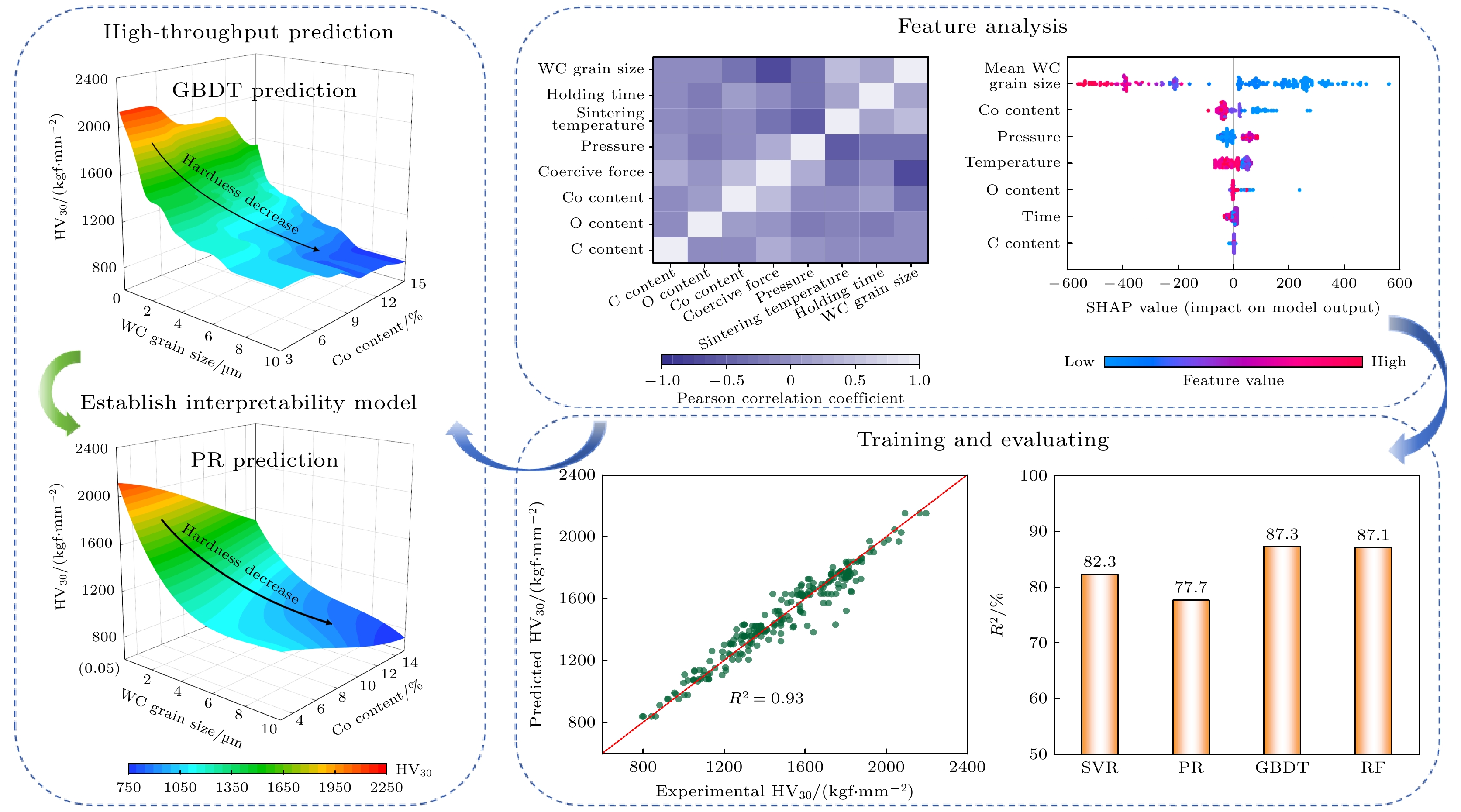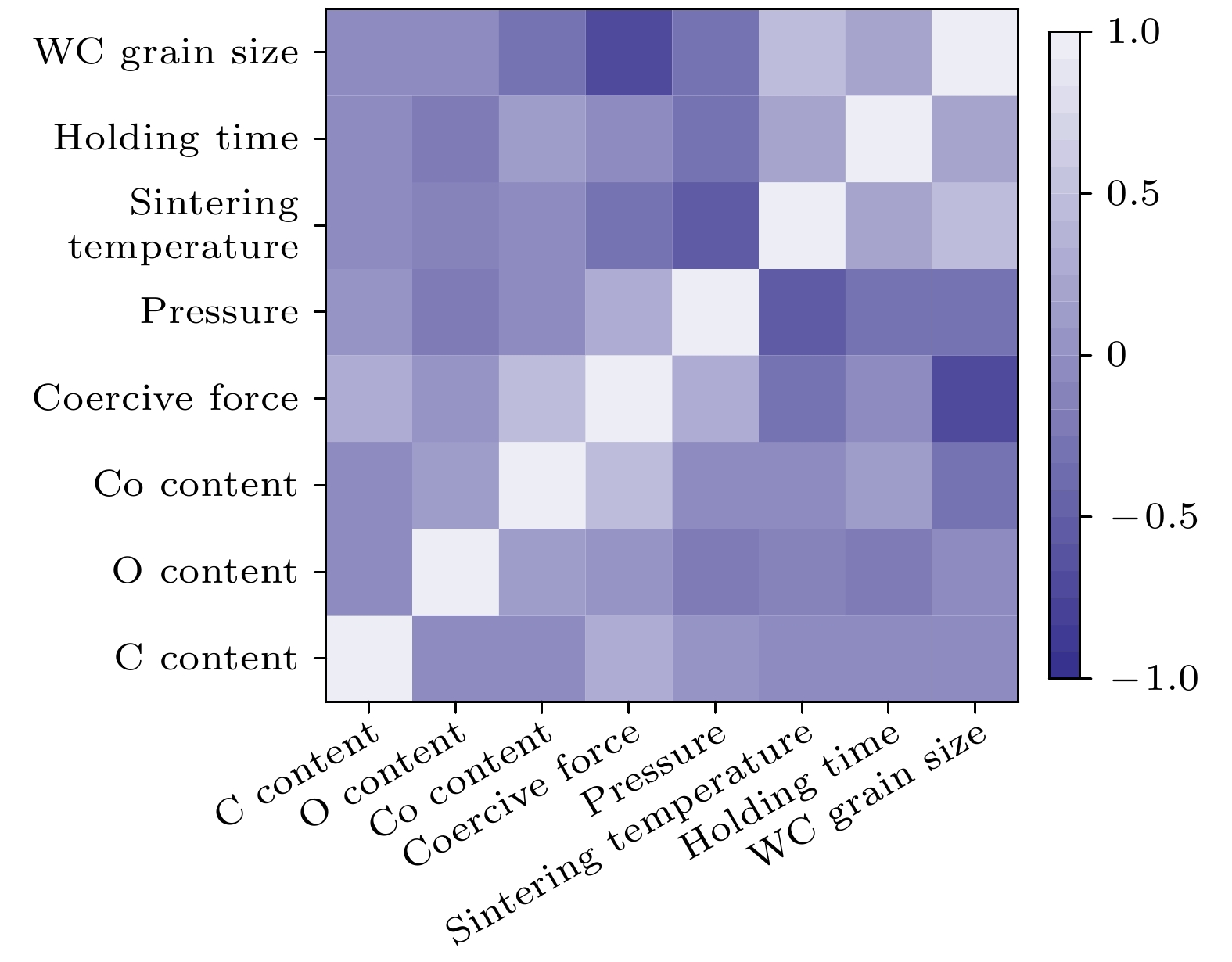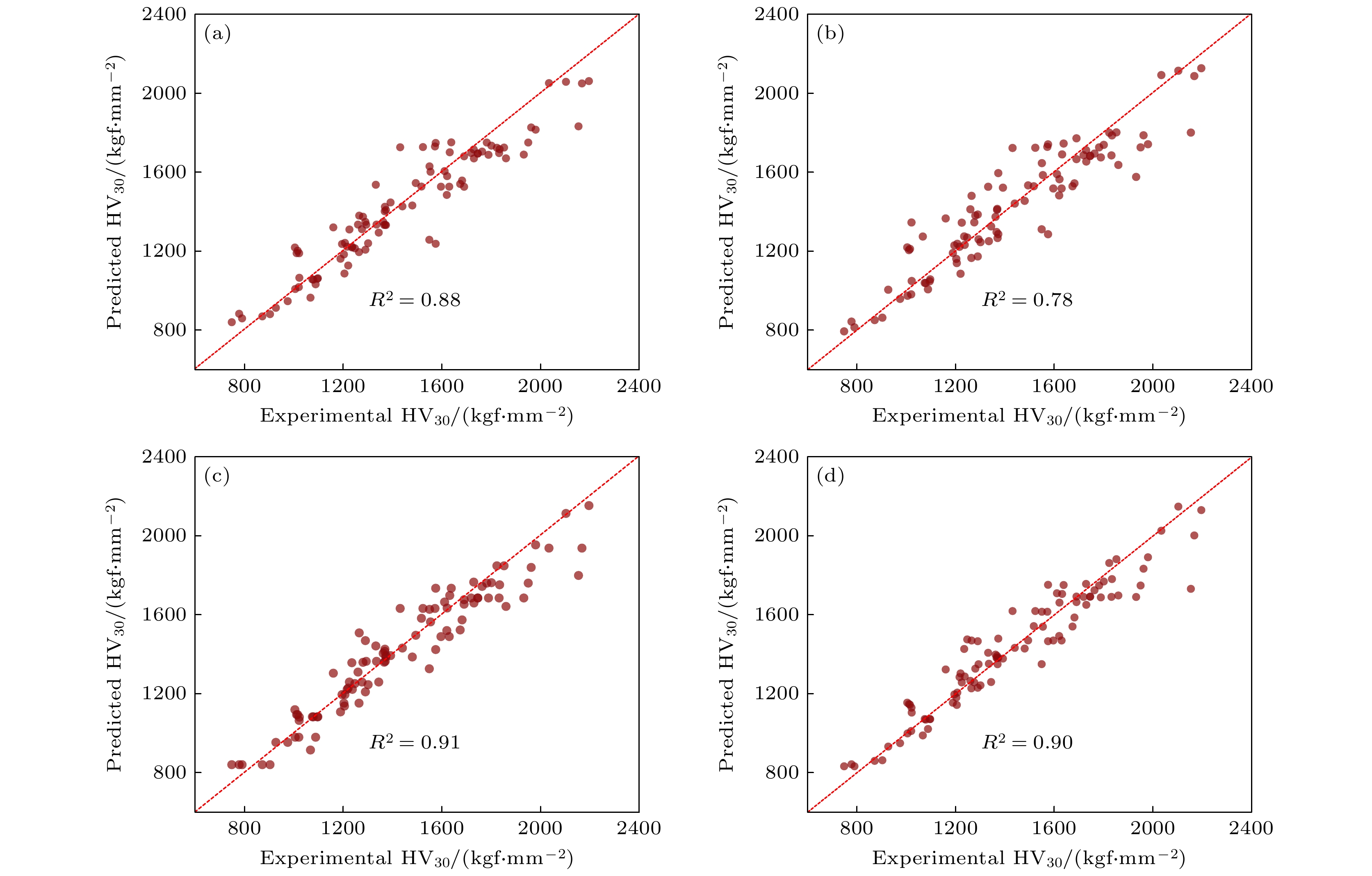-
The hardness of cemented carbides is a fundamental property that plays a significant role in their design, preparation, and application evaluation. This study aims to identify the critical factors affecting the hardness of WC-Co cemented carbides and develop a high-throughput predictive model for hardness. A dataset consisting of raw material composition, sintering parameters and characterization results of cemented carbides is constructed in which the hardness of cemented carbide is set as the target variable. By analyzing the Pearson correlation coefficient, Shapley additive explanations (SHAP) results, WC grain size and Co content are determined to be the key characteristics influencing the hardness of cemented carbide. Subsequently, machine learning models such as support vector regression (SVR), polynomial regression (PR), gradient boosting decision tree (GBDT), and random forest (RF) are optimized to construct prediction models for hardness. Evaluations using 10-fold cross-validation demonstrate that the GBDT algorithm model exhibits the highest accuracy and strong generalization capability, making it most suitable for predicting and analyzing the hardness of cemented carbides. Based on predictions from GBDT algorithm model, PR algorithm model is established to achieve high-precision interpretable prediction of the hardness of cemented carbides. As a result, a quantitative relationship between hardness and Co content and WC grain size is obtained, demonstrating that reducing grain size and Co content is the key to obtaining high hardness of cemented carbide. This research provides a data-driven method for accurately and efficiently predicting cemented carbide properties, presenting valuable insights for the design and development of high-performance cemented carbide materials.
-
Keywords:
- cemented carbide /
- hardness /
- machine learning /
- high-throughput prediction
[1] 丁业章, 叶寅, 李多生, 徐锋, 朗文昌, 刘俊红, 温鑫 2023 72 068703
 Google Scholar
Google Scholar
Ding Y Z, Ye Y, Li D S, Xu F, Lang W C, Liu J H, Wen X 2023 Acta Phys. Sin. 72 068703
 Google Scholar
Google Scholar
[2] Useldinger R, Schleinkofer U 2017 Int. J. Refract. Met. Hard Mater. 62 170
 Google Scholar
Google Scholar
[3] Springs G E 1995 Int. J. Refract. Met. Hard Mater. 13 241
 Google Scholar
Google Scholar
[4] Ghasali E, Orooji Y, Tahamtan H, Asadian K, Alizadeh M, Ebadzadeh T 2020 Ceram. Int. 46 29199
 Google Scholar
Google Scholar
[5] Ezquerra B L, Lozada L, Berg H V D, Wolf M, Sánchez J M 2018 Int. J. Refract. Met. Hard Mater. 72 89
 Google Scholar
Google Scholar
[6] Sun L, Yang T E, Jia C C, Xiong J 2011 Int. J. Refract. Met. Hard Mater. 29 147
 Google Scholar
Google Scholar
[7] Ding Q J, Zheng Y, Ke Z, Zhang G T, Wu H, Xu X Y, Lu X P, Zhu X G 2020 Int. J. Refract. Met. Hard Mater. 87 105166
 Google Scholar
Google Scholar
[8] Hu H X, Liu X M, Chen J H, Lu H, Liu C, Wang H B, Luan J H, Jiao Z B, Liu Y, Song X Y 2022 J. Mater. Sci. Technol. 104 8
 Google Scholar
Google Scholar
[9] Yu S B, Min F L, Ying G B, Noudem J G, Liu S J, Zhang J F 2021 Mater. Charact. 180 111386
 Google Scholar
Google Scholar
[10] Tang Y Y, Wang S N, Xu F Y, Hong Y K, Luo X, He S M, Chen L Y, Zhong Z Q, Chen H, Xu G Z, Yang Q M 2021 J. Alloy Compd. 882 160638
 Google Scholar
Google Scholar
[11] Jafari M, Enayati M H, Salehi M, Nahvi S M, Park C G 2014 Ceram. Int. 40 11031
 Google Scholar
Google Scholar
[12] Wang H, Zeng M Q, Liu J W, Lu Z C, Shi Z H, Ouyang L Z, Zhu M 2015 Int. J. Refract. Met. Hard Mater. 48 97
 Google Scholar
Google Scholar
[13] Singla G, Singh K, Pandey O P 2014 Ceram. Int. 40 5157
 Google Scholar
Google Scholar
[14] Liu W H, Wu Y, He J Y, Nieh T G, Lu Z P 2013 Scripta Mater. 68 526
 Google Scholar
Google Scholar
[15] Liu X M, Song X Y, Wei C B, Gao Y, Wang H B 2012 Scripta Mater. 66 825
 Google Scholar
Google Scholar
[16] Song X Y, Gao Y, Liu X M, Wei C B, Wang H B, Xu W W 2013 Acta Mater. 61 2154
 Google Scholar
Google Scholar
[17] Bonache V, Salvador M D, Fernández A, Borrell A 2011 Int. J. Refract. Met. Hard Mater. 29 202
 Google Scholar
Google Scholar
[18] Fang Z , Maheshwari P, Wang X, Sohn H Y, Griffo A, Riley R 2005 Int. J. Refract. Met. Hard Mater. 23 249
 Google Scholar
Google Scholar
[19] Fang Z Z, Wang X, Ryu T, Hwang K S, Sohn H Y 2009 Int. J. Refract. Met. Hard Mater. 27 288
 Google Scholar
Google Scholar
[20] Liu K, Wang Z H, Yin Z B, Cao L Y, Yuan J T 2018 Ceram. Int. 44 18711
 Google Scholar
Google Scholar
[21] 赵世贤, 宋晓艳, 刘雪梅, 魏崇斌, 王海滨, 高杨 2011 金属学报 47 1188
 Google Scholar
Google Scholar
Zhao S X, Song X Y, Liu X M, Wei C B, Wang H B, Gao Y 2011 Acta Metall. Sin. 47 1188
 Google Scholar
Google Scholar
[22] Roy A, Babuska T, Krick B, Balasubramanian G 2020 Scripta Mater. 185 152
 Google Scholar
Google Scholar
[23] Chanda B, Jana P P, Das J 2021 Comp. Mater. Sci. 197 110619
 Google Scholar
Google Scholar
[24] George K, Haoyan D, Chanho L, Samaei A T, Tu P, Maarten J, Ke A, Dong M, Peter K L, Wei C 2019 Acta Mater. 181 124
 Google Scholar
Google Scholar
[25] Bakr M, Syarif J, Hashem I A T 2022 Mater. Today. Commun. 31 103407
 Google Scholar
Google Scholar
[26] Ozerdem M S, Kolukisa S 2009 Mater. Design 30 764
 Google Scholar
Google Scholar
[27] Sun Y, Zeng W D, Han Y F, Ma X, Zhao Y Q, Guo P, Wang G, Dargusch M S 2012 Comp. Mater. Sci. 60 239
 Google Scholar
Google Scholar
[28] Zhang X Y, Dong R F, Guo Q W, Hou H, Zhao Y H 2023 J. Mater. Res. Technol. 26 4813
 Google Scholar
Google Scholar
[29] Catal A A, Bedir E, Yilmaz R, Swider M A, Lee C, El-Atwani O, Maier H J, Ozdemir H C, Canadinc D 2024 Comp. Mater. Sci. 231 112612
 Google Scholar
Google Scholar
[30] Guan Z H, Tian H X, Li N, Long J Z, Zhang W B, Du Y 2023 Ceram. Int. 49 613
 Google Scholar
Google Scholar
[31] Guan Z H, Li N, Zhang W B, Wang J J, Wang C B, Shen Q, Xu Z G, Peng J, Du Y 2022 Int. J. Refract. Met. Hard Mater. 104 105798
 Google Scholar
Google Scholar
[32] Rahadian H, Bandong S, Widyotriatmo A, Joelianto E 2023 Alex. Eng. J. 82 304
 Google Scholar
Google Scholar
[33] Zhong L, Guo X, Ding M, Ye Y C, Jiang Y F, Zhu Q, Li J L 2024 Comput. Electron. Agr. 217 108627
 Google Scholar
Google Scholar
[34] Someh N G, Pishvaee M S, Sadjadi S J, Soltani R 2020 J. Eval. Clin. Pract. 26 1498
 Google Scholar
Google Scholar
[35] Cervantes J, Lamont F G, Mazahua L R, Lopez A 2020 Neurocomputing 408 189
 Google Scholar
Google Scholar
[36] Tsai C Y, Kim J, Jin F, Jun M, Cheong M, Yammarino F J 2022 Leadership Quart. 33 101592
 Google Scholar
Google Scholar
[37] Khakurel H, Tanfique M F N, Roy A, Balasubramanian G, Ouyang G, Cui J, Johson D D, Devanathan R 2021 Sci. Rep. 1117149
 Google Scholar
Google Scholar
[38] Genuer R, Poggi J M, Malot C T, Vialaneix N V 2017 Big Data Res. 9 28
 Google Scholar
Google Scholar
-
图 4 典型参数对GBDT算法模型的测试集准确率(R2)、偏差(Bias)和方差(Var)的影响 (a) 弱学习器数量; (b) 树的最大深度; (c) 叶子节点最少样本数; (d) 内部节点再划分所需最小样本数
Figure 4. Performance of typical parameters on the testing set in terms of accuracy (R2)、bias (Bias) and variance (Var) based on GBDT model: (a) Number of estimator; (b) max depth; (c) min sample leaf; (d) min sample split.
-
[1] 丁业章, 叶寅, 李多生, 徐锋, 朗文昌, 刘俊红, 温鑫 2023 72 068703
 Google Scholar
Google Scholar
Ding Y Z, Ye Y, Li D S, Xu F, Lang W C, Liu J H, Wen X 2023 Acta Phys. Sin. 72 068703
 Google Scholar
Google Scholar
[2] Useldinger R, Schleinkofer U 2017 Int. J. Refract. Met. Hard Mater. 62 170
 Google Scholar
Google Scholar
[3] Springs G E 1995 Int. J. Refract. Met. Hard Mater. 13 241
 Google Scholar
Google Scholar
[4] Ghasali E, Orooji Y, Tahamtan H, Asadian K, Alizadeh M, Ebadzadeh T 2020 Ceram. Int. 46 29199
 Google Scholar
Google Scholar
[5] Ezquerra B L, Lozada L, Berg H V D, Wolf M, Sánchez J M 2018 Int. J. Refract. Met. Hard Mater. 72 89
 Google Scholar
Google Scholar
[6] Sun L, Yang T E, Jia C C, Xiong J 2011 Int. J. Refract. Met. Hard Mater. 29 147
 Google Scholar
Google Scholar
[7] Ding Q J, Zheng Y, Ke Z, Zhang G T, Wu H, Xu X Y, Lu X P, Zhu X G 2020 Int. J. Refract. Met. Hard Mater. 87 105166
 Google Scholar
Google Scholar
[8] Hu H X, Liu X M, Chen J H, Lu H, Liu C, Wang H B, Luan J H, Jiao Z B, Liu Y, Song X Y 2022 J. Mater. Sci. Technol. 104 8
 Google Scholar
Google Scholar
[9] Yu S B, Min F L, Ying G B, Noudem J G, Liu S J, Zhang J F 2021 Mater. Charact. 180 111386
 Google Scholar
Google Scholar
[10] Tang Y Y, Wang S N, Xu F Y, Hong Y K, Luo X, He S M, Chen L Y, Zhong Z Q, Chen H, Xu G Z, Yang Q M 2021 J. Alloy Compd. 882 160638
 Google Scholar
Google Scholar
[11] Jafari M, Enayati M H, Salehi M, Nahvi S M, Park C G 2014 Ceram. Int. 40 11031
 Google Scholar
Google Scholar
[12] Wang H, Zeng M Q, Liu J W, Lu Z C, Shi Z H, Ouyang L Z, Zhu M 2015 Int. J. Refract. Met. Hard Mater. 48 97
 Google Scholar
Google Scholar
[13] Singla G, Singh K, Pandey O P 2014 Ceram. Int. 40 5157
 Google Scholar
Google Scholar
[14] Liu W H, Wu Y, He J Y, Nieh T G, Lu Z P 2013 Scripta Mater. 68 526
 Google Scholar
Google Scholar
[15] Liu X M, Song X Y, Wei C B, Gao Y, Wang H B 2012 Scripta Mater. 66 825
 Google Scholar
Google Scholar
[16] Song X Y, Gao Y, Liu X M, Wei C B, Wang H B, Xu W W 2013 Acta Mater. 61 2154
 Google Scholar
Google Scholar
[17] Bonache V, Salvador M D, Fernández A, Borrell A 2011 Int. J. Refract. Met. Hard Mater. 29 202
 Google Scholar
Google Scholar
[18] Fang Z , Maheshwari P, Wang X, Sohn H Y, Griffo A, Riley R 2005 Int. J. Refract. Met. Hard Mater. 23 249
 Google Scholar
Google Scholar
[19] Fang Z Z, Wang X, Ryu T, Hwang K S, Sohn H Y 2009 Int. J. Refract. Met. Hard Mater. 27 288
 Google Scholar
Google Scholar
[20] Liu K, Wang Z H, Yin Z B, Cao L Y, Yuan J T 2018 Ceram. Int. 44 18711
 Google Scholar
Google Scholar
[21] 赵世贤, 宋晓艳, 刘雪梅, 魏崇斌, 王海滨, 高杨 2011 金属学报 47 1188
 Google Scholar
Google Scholar
Zhao S X, Song X Y, Liu X M, Wei C B, Wang H B, Gao Y 2011 Acta Metall. Sin. 47 1188
 Google Scholar
Google Scholar
[22] Roy A, Babuska T, Krick B, Balasubramanian G 2020 Scripta Mater. 185 152
 Google Scholar
Google Scholar
[23] Chanda B, Jana P P, Das J 2021 Comp. Mater. Sci. 197 110619
 Google Scholar
Google Scholar
[24] George K, Haoyan D, Chanho L, Samaei A T, Tu P, Maarten J, Ke A, Dong M, Peter K L, Wei C 2019 Acta Mater. 181 124
 Google Scholar
Google Scholar
[25] Bakr M, Syarif J, Hashem I A T 2022 Mater. Today. Commun. 31 103407
 Google Scholar
Google Scholar
[26] Ozerdem M S, Kolukisa S 2009 Mater. Design 30 764
 Google Scholar
Google Scholar
[27] Sun Y, Zeng W D, Han Y F, Ma X, Zhao Y Q, Guo P, Wang G, Dargusch M S 2012 Comp. Mater. Sci. 60 239
 Google Scholar
Google Scholar
[28] Zhang X Y, Dong R F, Guo Q W, Hou H, Zhao Y H 2023 J. Mater. Res. Technol. 26 4813
 Google Scholar
Google Scholar
[29] Catal A A, Bedir E, Yilmaz R, Swider M A, Lee C, El-Atwani O, Maier H J, Ozdemir H C, Canadinc D 2024 Comp. Mater. Sci. 231 112612
 Google Scholar
Google Scholar
[30] Guan Z H, Tian H X, Li N, Long J Z, Zhang W B, Du Y 2023 Ceram. Int. 49 613
 Google Scholar
Google Scholar
[31] Guan Z H, Li N, Zhang W B, Wang J J, Wang C B, Shen Q, Xu Z G, Peng J, Du Y 2022 Int. J. Refract. Met. Hard Mater. 104 105798
 Google Scholar
Google Scholar
[32] Rahadian H, Bandong S, Widyotriatmo A, Joelianto E 2023 Alex. Eng. J. 82 304
 Google Scholar
Google Scholar
[33] Zhong L, Guo X, Ding M, Ye Y C, Jiang Y F, Zhu Q, Li J L 2024 Comput. Electron. Agr. 217 108627
 Google Scholar
Google Scholar
[34] Someh N G, Pishvaee M S, Sadjadi S J, Soltani R 2020 J. Eval. Clin. Pract. 26 1498
 Google Scholar
Google Scholar
[35] Cervantes J, Lamont F G, Mazahua L R, Lopez A 2020 Neurocomputing 408 189
 Google Scholar
Google Scholar
[36] Tsai C Y, Kim J, Jin F, Jun M, Cheong M, Yammarino F J 2022 Leadership Quart. 33 101592
 Google Scholar
Google Scholar
[37] Khakurel H, Tanfique M F N, Roy A, Balasubramanian G, Ouyang G, Cui J, Johson D D, Devanathan R 2021 Sci. Rep. 1117149
 Google Scholar
Google Scholar
[38] Genuer R, Poggi J M, Malot C T, Vialaneix N V 2017 Big Data Res. 9 28
 Google Scholar
Google Scholar
Catalog
Metrics
- Abstract views: 5667
- PDF Downloads: 108
- Cited By: 0
















 DownLoad:
DownLoad:











